Meat thermometer purchasing advice: how to choose the right product
- What You Need to Know
- Grill thermometers use sensors to detect the temperature inside the grilled food and provide information about the perfect cooking point.
- Barbecue thermometers are easy to use and suitable for professionals as well as hobby barbecuers.
- Measuring devices with digital display and additional features such as a Bluetooth, WLAN or radio connection have numerous advantages over analogue devices.
- The temperature sensor is mounted directly on the unit or connected to it by a cable.
The core temperature is what counts
Barbecue thermometers enable precise cooking on charcoal, gas and electric barbecues. Professional and occasional grillers can determine the optimal cooking point with ease. With a thermometer, dry steaks are finally a thing of the past. Instead, the grilled food is prepared gently and remains tender and juicy. Temperatures that are too high cause the liquid inside the meat to condense before a tasty crust has formed on the outside.
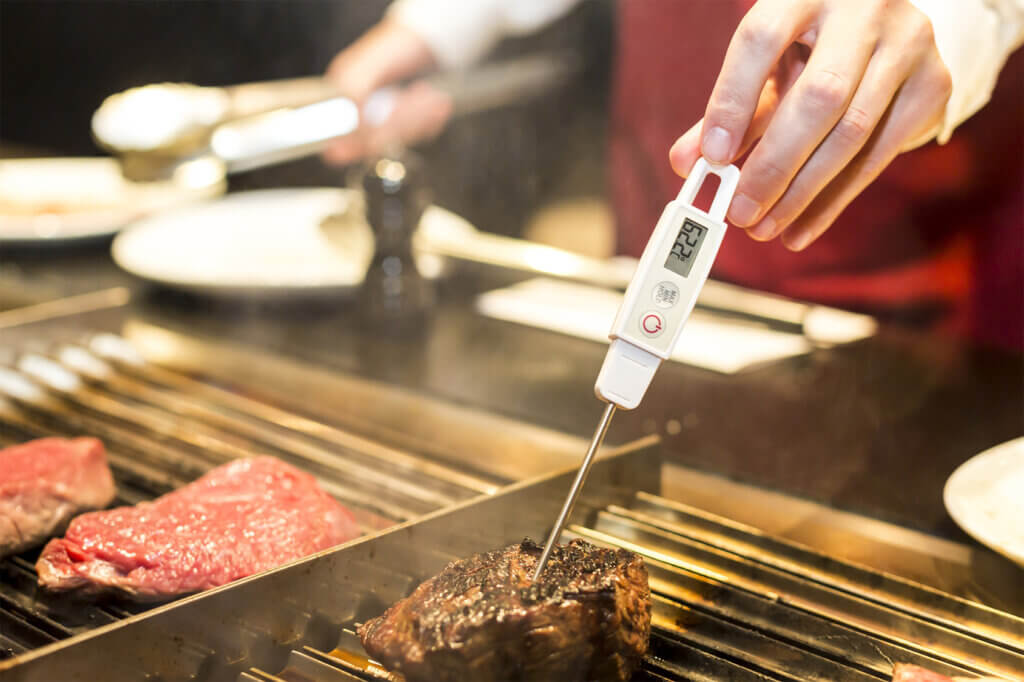
Design and function of a barbecue thermometer
The main components of a barbecue thermometer are the measuring sensor and the display. The former has a temperature sensor that is inserted into the grilled food and measures the temperature inside steak, fish, poultry, grilled cheese or even compact vegetables. The display shows the measured value either in degrees Celsius or degrees Fahrenheit. Some measuring devices also have a second sensor that determines the temperature inside the grill when the lid is closed. These thermometers are not only indispensable helpers for barbecues, but can also be used in the oven of the kitchen cooker.
The display can be conveniently attached directly to the barbecue. Thermometers with magnets are particularly popular, as they do not require screws or glue. Radio thermometers call the grill master when the desired core temperature is reached. Devices with Bluetooth technology also alert the user via a smartwatch or mobile phone. The barbecue thermometer gets the energy it needs for operation from a button cell or a standard AAA battery.
International pinpoint grilling
Barbecue thermometers with digital LCD display have a set button with which users can set the display to either degrees Celsius or degrees Fahrenheit. This means that the barbecue helper can be used internationally.
The different types
Barbecue thermometers come in a wide product range with versatile designs. Basically, however, two main types can be distinguished.
In the first version, the measuring sensor is permanently connected to the display. The grill master uses it to check the core temperature of the grilled food from time to time. This version has the following advantages and disadvantages:
Pro points
- Fast temperature measurement
- Optimal for several pieces of meat
- Sensor retractable
- Lightweight and space saving
- Ideal companion for holidays and camping
- Choice of classic analogue or digital display
Drawbacks
- Allows only spadic measurements
- Grilled food must be pierced several times
- Measurement accuracy lags behind cable sensors
The second thermometer type has a cable connection between the measuring sensor and the display. This allows the sensor to remain in the grill food during the entire cooking time. This variant has the following advantages and disadvantages:
Pro points
- Sensor can remain in the food
- Very well suited for large frying chamber
- Different types of meat and cooking levels can be stored
- Equipment with timer and additional features
Drawbacks
- Cable requires additional cleaning
The latest barbecue thermometers additionally offer an alternative temperature detection by means of infrared sensors. This has the advantage that the food does not have to be pierced and the juice remains inside the meat. Barbecue chefs can check the temperature as often as they like without reducing the quality of the barbecued food. On the other hand, the fact that the measurements can only be taken selectively has a disadvantage. The infrared thermometer is not suitable for permanent measurements. In addition, it requires more energy for operation, which noticeably shortens the battery life.
Classic analogue or digital display?
If a barbecue thermometer with a fixed connection between sensor and display is one of your favourites, the question remains about the type of display: Do you prefer familiar analogue indications or a digital LCD display? The right type ultimately results from the type and frequency of use.
Barbecue thermometer with analogue display
For the occasional barbecue on holiday or during a bike tour, a simple, inexpensive model with an analogue display is sufficient. The price range for these models is between 10 and 20 euros. Pocket-knife-sized thermometers with a fold-out probe are particularly practical. They are light and take up little space in your luggage. The lightest barbecue thermometers weigh barely 30 grams, whereas professional models weigh up to 400 grams.
Barbecue thermometers with analogue display provide information about the measured temperature on a scale. The scale usually ranges from 180 to 220 degrees Celsius. Analogue thermometers are characterised by their particular durability, extremely good heat resistance and very easy handling. However, the precision of the temperature measurement lags behind that of digital models.
Barbecue thermometer with digital display
For frequent garden parties at the barbecue, a comfortable radio barbecue thermometer is recommended, which may also cost a little more. The average price here is between 30 and 60 euros, professional devices even cost up to 200 euros. Whether a basic or high-end device, the precision and speed of the temperature measurement are decisive for the purchase of a barbecue thermometer.
The most reliable measuring results are provided by barbecue thermometers with a digital LCD display, whose sensor can remain in the meat during the entire cooking process. They have a measuring range of up to 380 degrees Celsius and are equipped with a variety of practical features such as an alarm function, Wi-Fi and Bluetooth. The differences in measuring speed are also considerable: depending on the device, the measuring time is between 4 and 25 seconds.
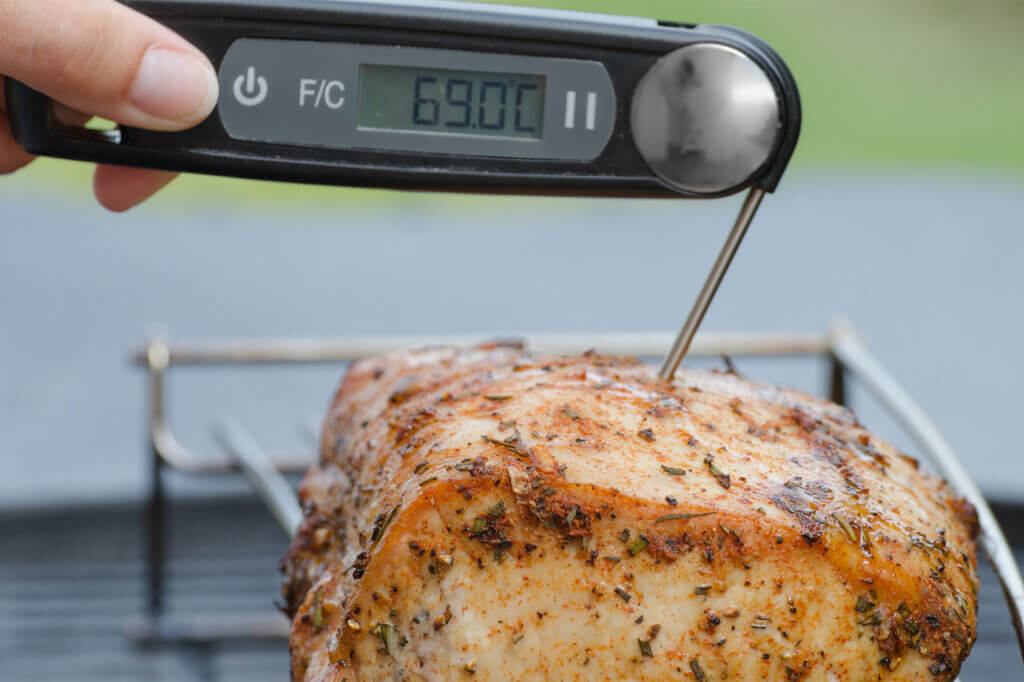
Bluetooth, radio, WLAN and Co. : The versatile features
Digital wireless barbecue thermometers give barbecue masters a lot of leeway. Unlike wired BBQ thermometers, they do not have to be near the barbecue all the time, because the measuring probe transmits its data wirelessly to the display device, which users sometimes carry with them like a wristwatch. Users programme the desired core temperature in advance. When this is reached, the device sends an alarm signal. A wireless thermometer is particularly advantageous when using a kettle grill or smoker with the lid closed.
Newer models are able to communicate with smart devices via WLAN or Bluetooth. Bluetooth barbecue thermometers also transmit the measured data to the smartwatch, tablet or mobile phone. All that is required is to install the necessary app on the end device. In addition to the temperature measurements, they give users recipe ideas as well as a wealth of tips and tricks for a perfect barbecue.
The barbecue thermometer is not lagging behind the advancing digitalisation. The latest generation can be integrated into modern smart home installations via WLAN. To do this, users usually connect the sensor to the base station with the help of a cable. As soon as they have integrated it into the household’s Wi-Fi network, it transmits the result of the measurements to a notebook, tablet or smartwatch.
The range
When using Bluetooth, WLAN or radio barbecue thermometers, special attention must be paid to the range of the corresponding network. The range of wireless thermometers is limited to 100 metres. With Bluetooth connections, the range is between five and eight metres.
What matters when buying
Since the sensor is constantly exposed to high temperatures, the quality of the material used is the most important selection criterion when buying a barbecue thermometer. 18/10 stainless steel is very reliable: it not only has a special heat resistance and dimensional stability, but is also hygienic, acid-proof, rust-proof and will provide years of trouble-free service.
Heat resistance is an important keyword, because not only the sensors are exposed to high temperatures. A display attached to the grill must also be absolutely heat-resistant. Other purchase criteria are largely determined by your personal usage habits and needs. However, the following parameters should definitely be taken into account:
- Temperature range of the measurements
- Speed and precision of the measurements
- Type of transmission of the measured values
- Type and size of the display
- Storable meat types and cooking stages
- Number of sensors available
- Probe length
- Equipment with alarm function
- Operating comfort
Length, nature and number of temperature sensors
The heat-resistant, waterproof and rustproof sensors made of high-quality stainless steel are the heart of the barbecue thermometer. In addition to the material quality, their length plays a not insignificant role. It ranges from 5 to 17 centimetres. While five centimetre long temperature sensors are just about sufficient for a hearty beef steak or grilled cheese, larger roasts or poultry in one piece require a larger calibre. Here, it is not only recommended for beginners and occasional grillers to use models with correspondingly long sensors.
While basic models only have one temperature sensor for the food to be grilled, almost all digital grill thermometers are equipped with two sensors, the second of which measures the temperature in the cooking chamber. Particularly high-quality devices come with up to four additional sensors. They can be connected to the end device if required. With them, grill masters can easily monitor several pieces of grilled food from different types of meat – an absolute must for grill fans and professionals.
Illumination and alarm function: The display and its operation
Accurate monitoring of the core temperature of the grilled meat also requires a user-friendly terminal with an easy-to-read display. The display of the BBQ thermometer, whether analogue or digital, should in any case be large enough so that the values can be easily recognised. For round models, a diameter of five to six centimetres should be set as a minimum. The diameter of high-quality devices is much larger. A backlight improves readability, but shortens battery life. It deserves more attention than the question of a multicolour display.
An alarm function is an indispensable feature of a barbecue thermometer. This informs you when the core temperature of the grilled food has been reached and saves you from having to constantly stand next to the grill during cooking. Wireless barbecue thermometers should also warn users when the end device with the display leaves the range of the temperature probes and transmission of the data is no longer possible.
User-friendly operation is essential for effective use of the barbecue thermometer. Corresponding buttons should be clearly arranged and the programming of individual cooking levels as well as different types of meat should be simple and intuitive. The options for attaching the display to the grill also deserve some attention. Magnetic holders are more practical than the eyelets often offered.
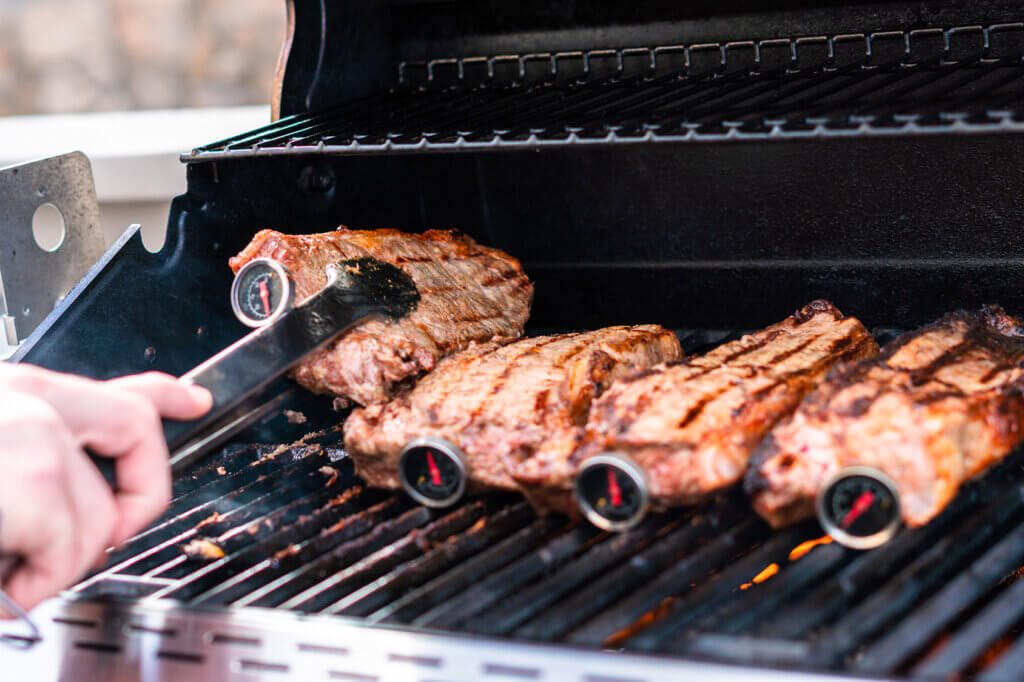
Bluetooth barbecue thermometer on the go: the usefulness of additional gadgets
While WLAN thermometers are reserved for use in home gardens, simple radio and Bluetooth models also make sense in comparatively small versions. They can make the cosy barbecue evening on holiday or during a happy bike ride more relaxed than thermometers without this feature. Even a simple radio thermometer can inform you about reaching the perfect cooking point over a distance of up to 100 metres. This means that the barbecue does not necessarily have to be placed right next to the tent or camper van and interfere with the fresh evening air.
A Bluetooth barbecue thermometer performs the same useful services. After all, nowadays a smartphone with the appropriate equipment is always at hand. Users should download, install and try out the necessary app before they go on holiday. Some barbecue thermometers have developed into true all-rounders for holidays. Attractively designed, their terminals double as night lights and function as alarm clocks in the morning. The temperature probes can even be used on a rotisserie.
Cleaning and care for a long service life
The care of a BBQ thermometer is not particularly complex, but does require some care. Cleaning analogue barbecue thermometers is simple and undemanding. It is sufficient to clean the probe thoroughly with a soft, damp cloth. This should be done immediately after use, if possible, so that residues from the cooking juices do not dry on. The use of washing-up liquid is not recommended: Small particles of the lotion remain on the sensor even after wiping it off and could get into the grilled food the next time it is used. This would not only have a negative impact on the taste of the food, but could also have adverse health effects.
Are barbecue thermometers waterproof?
Analogue barbecue thermometers can withstand an accidental water bath without damage. After thorough drying, they can be reliably used again after a short time.
Modern digital barbecue thermometers are somewhat more demanding in terms of cleaning and care. To protect the waterproof and fireproof cables and the sensitive LCD display from damage, be careful when using water. You should clean the probes with a soft, slightly damp, but never wet cloth. In this case, too, it is advisable to avoid using washing-up liquid or other additives. Many manufacturers offer special cleaning cloths to remove bacteria and germs after use. They are not only suitable for cleaning the temperature sensors, but also for removing grease splashes from the display or cable.
In general, the higher the quality and more comprehensive the equipment of a barbecue thermometer, the more caution is required when cleaning it. If it is not used for a longer period of time, for example in winter, it is recommended to remove the button cells or batteries from the device. Leakage could permanently damage the sensitive contacts.
Finally, here are some general tips on using a barbecue thermometer:
- Always prick the meat at its thickest point.
- Do not touch any bones when piercing. They heat up faster than the meat and falsify the measurement result.
- Do not prick the meat more often than necessary to prevent the meat juices from escaping.
- Place the thermometer in the grilled cheese before cooking; it will collapse later.

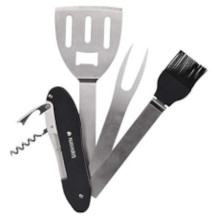
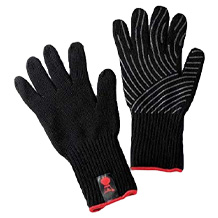
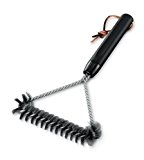
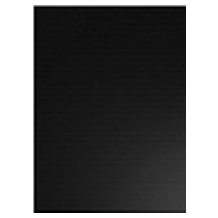
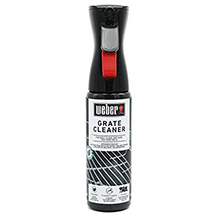
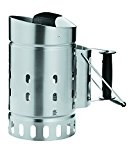
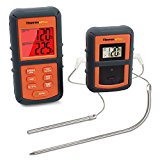
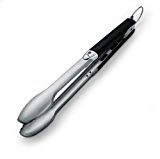

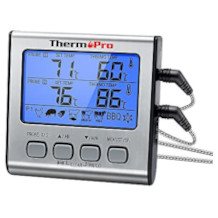
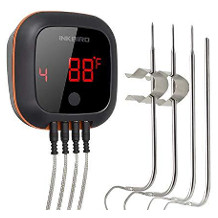
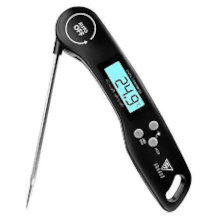
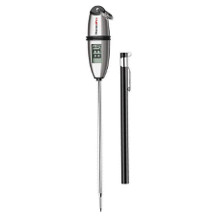
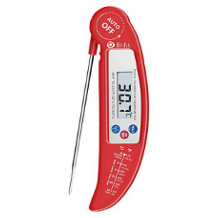

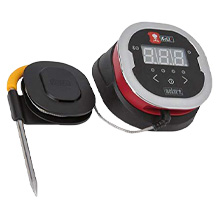
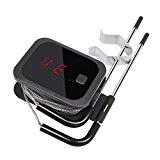

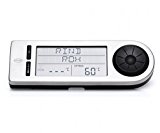
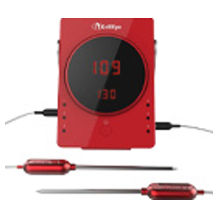
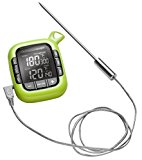
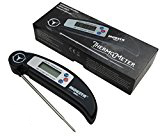
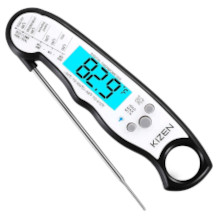

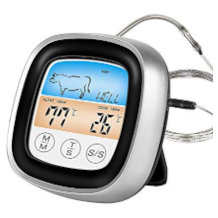
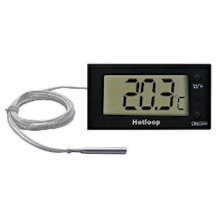

 12,851 reviews
12,851 reviews